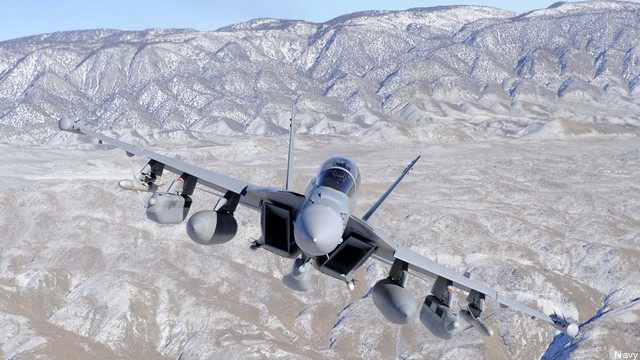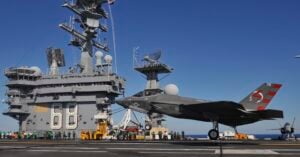
EA-18G Growler
CAPITOL HILL: The Pentagon has launched a wide-ranging study of electronic warfare, looking across the services at major platforms such as the EA-18G Growler and the F-35’s three versions.
“We are doing right now in the Department of Defense a study that looks at all electronic attack[:] what is the situation in electromagnetic warfare across the spectrum in our maneuver,” Adm. Jonathan Greenert told the House Appropriations defense subcommittee yesterday.
That study that goes far beyond any individual weapons system to examine America’s entire capability to control the electromagnetic spectrum, on which our networks, sensors, and precision weapons all depend.
Before making any decisions on specific platforms like the Growler, “I want to hear from the whole Department of Defense, because we are the jammer provider,” Greenert said. The Air Force has a small number of electronically sophisticated but physically ungainly EC-130H Compass Call aircraft, of which they plan to retire many. The Army and Marines have a host of short-range tactical jammers to defeat roadside bombs. But only the Navy provides a survivable aircraft capable of conducting electronic warfare in contested airspace.
The Navy’s unfunded requirements list for 2015 included 22 more EA-18G Growlers, a variant of the Navy’s standard strike fighter, the F/A-18E/F Super Hornet. Congress funded 15. There are no Growlers in the 2016 budget request, so both Boeing — which builds the aircraft — and Congress are eager to hear whether the Navy would like another plus-up. So are reporters, whose questions Adm. Greenert and Navy Secretary Ray Mabus deftly parried after yesterday’s hearing.
“We’re evaluating… how many JSFs vs. Super Hornets do we want to have” for the long-term in the 2020s, Greenert said when asked if a reduction in F-35 Joint Strike Fighter buys would require an increase in F-18s. “I haven’t had a discussion yet with the secretary” — brand-new Defense Secretary Ashton Carter — “about the unfunded requirement list,” he said. Many reports indicate there may not even be one this year.
Are you sending a signal to Boeing that you don’t need more Growler/Hornet aircraft, I asked?
“I don’t send signals, I talk to my boss,” Greenert said, turning to the Navy Secretary.

Adm. Jonathan Greenert (left); Navy Sec. Ray Mabus (right)
“The F-18 line currently, because of the 15 Growlers that were given in the ’15 budget, is going to go through ’17,” Mabus said. “We are working with Boeing in terms of how you smooth that out” — perhaps by adding refurbishment work for the current F-18 fleet — and we know that they are looking at foreign sales to keep that line going.”
Super Hornet sales abroad, however, have been distinctly unspectacular. “So far it’s been 20 years and they’ve got one customer[:] Australia,” said Richard Aboulafia, aviation industry analyst extraordinaire at the Teal Group. (More countries own the older F-18A, B, C, and D models, but those are no longer in production). “Part of it is the price point,” Aboulafia told me. “It was getting close to an F-15, and the F-15 really is in a class by itself in terms of…sheer range and payload and combat effectiveness.” For Boeing, which builds both planes, “it was easy to steer customers towards the F-15”: South Korea, Singapore, Saudi Arabia. “You’ve also got pressure from F-35, pressure from Eurofighter, pressure from Rafale.”
That said, Aboulafia went on, several countries are looking hard at Super Hornets: Denmark, Kuwait, Malaysia, Canada — which owns CF-18 Hornets — and Qatar, which is probably Boeing’s best shot at a big sale in the next few years.
But to keep the Boeing line running after the current US contract ends in 2017, “some order has to be placed within say, a year-and-a-half of now,” Aboulafia said. The closer to 2017, he said, the more expensive it gets to save the line, because the supplier base will have already started packing up. “It’s a piece of cake later this year,” he said. “Early next year might get a little pricier… end of 2016, game over.”
That’s a tight timeline for an international competition. If the Navy wants to keep the F-18/EA-18 line alive and keep open its options to buy more of the aircraft, it probably has to order some.
Congress could add aircraft regardless of what the Navy wants. But that’s less likely in tight budgetary times than it once was. Politically it’s much easier to plus-up the budget for one of the service’s unfunded requirements than for something it doesn’t really want.
“I can tell you from personal experience that it’s real tough to sell a combat system when the home service doesn’t seem to want it,” said Loren Thompson, a defense industry analyst and consultant. What’s more, he told me, “with budget caps firmly in place, adding money to buy more Super Hornets would require finding some other program that could serve as a bill-payer.”
Traditionally, pundits have pitted the Super Hornet and its Growler variant against the F-35 Joint Strike Fighter. The Navy has always been the least enthusiastic of the three services buying the JSF, expressing deep doubts about the long-term value of stealth, but Thursday Greenert took pains to emphasize stealth wasn’t the only thing the F-35 had going.

A Navy F-35C conducts its first-ever arrested landing aboard the carrier USS Nimitz
“It’s not just stealth, it’s so much more,” he told the subcommittee. “It’s got tremendous range — you almost double the range from an aircraft carrier; [it] carries more ordnance; [it] has a detection radar for air-to-air which is much advanced, and it can network with other aircraft and other assets, ships and the like. [It can] jam and detect and share information…..Each of those is a tremendous leap unto itself.”
That doesn’t sound like someone eager to sacrifice F-35s to buy more Super Hornets and Growlers.
So if Congress, foreign customers, and cutting the F-35 can’t save the F-18 factory, it’s up to the Pentagon — which brings us back to that electronic warfare study.
Greenert’s description of the study — that it covers “all electronic attack” — sounds extraordinarily broad and vague. I’m still nudging the Pentagon to give me more details. But Aboulafia says that, from the Growler program’s perspective, the whole study boils down to one thing: “whether or not to increase the number of jammer planes on each carrier, pure and simple.”
As electronic warfare threats and countermeasures increase, the Navy is experimenting with new Growler tactics that take advantage of the aircrafts’ passive sensors, rather than having them transmit all the time. Those new tactics, though, require three jamming aircraft in the air instead of the traditional two. Keeping three planes in the air at any given time for any length of time requires a larger squadron on the aircraft carrier: seven or eight Growlers instead of the current five. Adding two or three Growlers for each of 10 carrier air wings is 20 to 30 aircraft, not counting spares needed to account for maintenance, accidents, and training more pilots.
That’s a big investment. But electronic warfare is increasingly a big priority, not just for the Navy but for the Office of the Secretary of Defense. The Pentagon’s chief of research, Alan Shaffer, has warned the US has lost “dominance in the electromagnetic spectrum,” on which all our networks and sensors rely, and control of the spectrum underlies deputy secretary Bob Work’s new “offset strategy” to counter China and Japan. The Defense Science Board has identified $2 billion a year of shortfalls in electronic warfare. With Growlers the cutting edge of American electronic warfare, it’s quite likely the Pentagon study will say we need more — and even in tight budgetary times, it’s possible they’ll actually get them.
Northrop sees F-16 IVEWS, IBCS as ‘multibillion dollar’ international sales drivers
In addition, CEO Kathy Warden says the company sees a chance to sell up to five Triton UAVs to the NATO alliance.


























